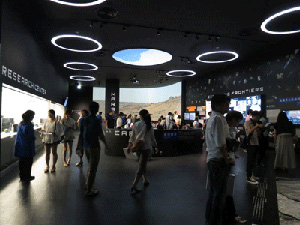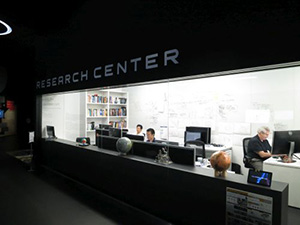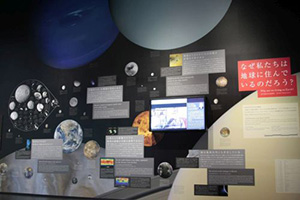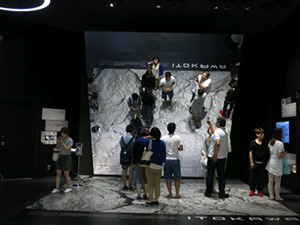
The exhibit attracts many visitors in
daytime and night time.

We are working inside the lab at the corner
of the exhibit area.

We change the size of the text depending
on the importance.

Some of those first attracted by the experiencing-style exhibit carefully read the explanations.
Natural history of the solar system
This is an evolutionary era for Planetary Science. More than 60 solar-system bodies have been explored by more than 120 space missions, which have yielded enormous amount of exploration data. Recent advances in space exploration are especially noticeable, reminiscent of the age of discovery; at that time, evolutional advances in developing ships and the discovering of new sea routes were fundamental for obtaining materials from a new world. Similarly, evolutionary engineering advances in making spacecraft with new reconnaissance instruments help us obtain vast knowledge regarding the solar system.
Early stage of natural history is essentially supported by the appreciation of the diversity in nature discovered in a new world. The same thing is happening in solar-system science. Various sceneries of solar-system bodies observed by spacecraft give us the impression that a whole new field exists in natural history. Careful descriptions and analyses of data observed through robotic missions will be an important new step for understanding solar-system bodies including the Earth. We consider such research will lead to the development of a new academic field maybe called the natural history of the solar system.
In order to explore such a new field of science, the University of Tokyo initiated a new branch of scientific investigation, called Space Exploration, Education, and Discovery (SEED). At SEED, 5 researchers are working on analyses of data obtained by space missions and the development of new instruments for future space missions. In addition to such pure and fundamental science research, outreach will become an important mission to explore the natural history of solar system, because the space exploration missions should be widely supported by the public.
We consider that providing up-to-date space science to the public is essential for the public to evaluate the importance of space missions. This is a difficult task to do only inside the university or even a space agency because (1) it is difficult to approach many people and (2) a rapidly advancing science field, such as solar-system science, is fundamentally challenging for outreach programs because the documents or exhibits should be frequently updated.
Given such ground, we decided to collaborate with the Tokyo Dome Corporation, which started the new Space Museum project, TeNQ. SEED members closely work together to organize the science exhibit of the museum. In addition, the SEED members work full time at the exhibit hall, which includes updating the exhibit based on the new knowledge obtained through scientific research. We believe that this is the first experimental exhibit in the world. The idea is that by exhibiting the entire laboratory activities, we can serve as an information station for solar system exploration. We refer to such an exhibit as the exhibit of the natural history of the solar system.
Tokyo Dome, which is literally located at the center of Tokyo and always densely populated, is one of the best locations for the above-mentioned activities. We developed the exhibit of the natural history of the solar system to mainly show up-to-date space science, installing it in the science corner of the TeNQ space museum. All text of our exhibit is multilingual written by native-speaking researchers. Altogether, we display about 100,000 characters, which greatly exceeds the number of characters of an ordinary exhibit. Thanks to the technique that we developed through previous exhibition and the high-definition digital signage systems, however, visitors do not realize the amount of information.
Since the grand opening in July 2014, TeNQ has been steadily crowded, with tickets often being sold out. Though visitors may come to see the theaters and/or partake in the amusement equipment, they eventually examine our exhibit of natural history of the solar system. We, the SEED members as one of the exhibit in the science corner, often are surprised that many visitors carefully look at detailed descriptions of our exhibit. In the future, not only will we update the exhibit materials, but we will also observe the behaviors of the guests, which will provide us useful information to modify the exhibit for better presentation. At the same time, from such a unique atmosphere, we are working hard to create unique and fundamental research results.
Associate professor
Hirdy Miyamoto
TeNQ / Tokyo Dome City
Hirdy Miyamoto Laboratory (home page)
Hirdy Miyamoto Laboratory (information page)
Natural history of the solar system (home page)

